Click on images to enlarge
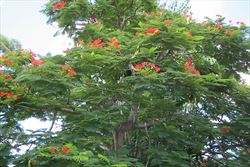
habit (Photo: Sheldon Navie)
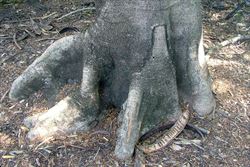
butressed base of main trunk (Photo: Sheldon Navie)
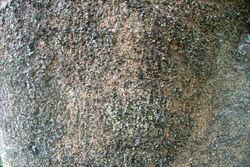
close-up of relatively smooth bark on main trunk (Photo: Sheldon Navie)

younger branch with pale brown raised spots and swollen bases of leaf stalks (Photo: Sheldon Navie)

leaf-like stipules at the bases of new leaves (Photo: Sheldon Navie)
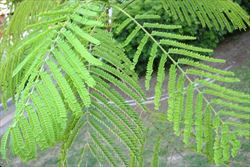
large twice-compound leaves (Photo: Sheldon Navie)

close-up of leaflets showing their paler undersides (Photo: Sheldon Navie)

flower buds (Photo: Sheldon Navie)

flowers (Photo: Sheldon Navie)

close-up of flowers (Photo: Sheldon Navie)

immature fruit (Photo: Sheldon Navie)
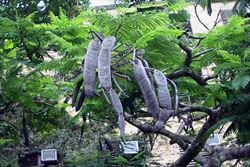
mature fruit (Photo: Sheldon Navie)

close-up of mature fruit that has already released its seeds (Photo: Sheldon Navie)
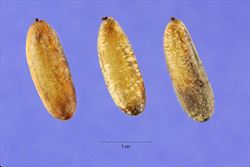
close-up of seeds (Photo: Steve Hurst at USDA PLANTS Database)
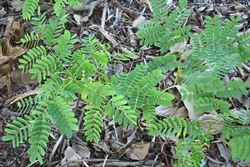
seedlings (Photo: Sheldon Navie)

young plants (Photo: Sheldon Navie)
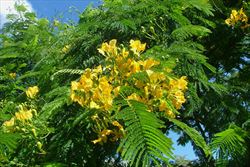
the yellow-flowered form of poinciana, which is generally known by the name Delonix regia var. flavida (Photo: Sheldon Navie)

dense infestation in northern Queensland (Photo: Sheldon Navie)
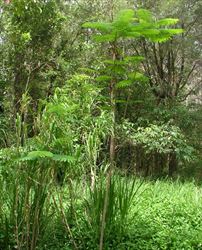
saplings growing in bushland in suburban Brisbane (Photo: Sheldon Navie)
Scientific Name
Delonix regia (Bojer ex Hook.) Raf.
Synonyms
Poinciana regia Bojer ex Hook.
Family
Caesalpiniaceae (Queensland, the ACT, Victoria, Tasmania, Western Australia and the Northern Territory)Fabaceae: sub-family Caesalpinioideae (New South Wales)Leguminosae (South Australia)
Common Names
flambouyant, flamboyant, flame tree, flametree, peacock flower, peacock-flower, poinciana, royal poinciana, red tree
Origin
Native to northern and western Madagascar.
Cultivation
Widely cultivated as a garden and street tree, and particularly common in the warmer parts of Australia. A form with yellow flowers (commonly known as Delonix regia var. flavida) is occasionally also seen in cultivation.
Naturalised Distribution
Naturalised primarily in the northern parts of Australia. It is becoming common in the northern parts of the Northern Territory (i.e. near Darwin, on the Cobourg Peninsula and along the Daly River) and in northern Queensland (e.g. on coral cays off Cape York Peninsular and near Cairns). Occasionally naturalised in central and south-eastern Queensland, in the coastal districts of northern Western Australia, and in some inland parts of northern New South Wales.
Also naturalised on Christmas Island, in south-eastern USA (i.e. Florida) and on several Pacific islands (i.e. Hawaii, Fiji, the Solomon Islands, the Galapagos Islands, Niue and New Caledonia).
Habitat
A weed of riparian vegetation, rainforests, coastal monsoon vine thickets, roadsides, disturbed sites and waste areas in tropical and sub-tropical regions.
Habit
A medium-sized tree that usually develops a broad and spreading crown. It usually grows less than 10 m tall, but occasionally reaches up to 15 m in height. It loses most or all of its leaves during the dry season in northern Australia (i.e. it is deciduous), but retains most of its foliage year-round in eastern Australia.
Distinguishing Features
- a broad and spreading tree that may lose some or all of its leaves during the dry season.
- its trunk is covered in a relatively smooth pale brown or greyish-coloured bark.
- its alternately arranged twice-compound leaves (15-60 cm long) have large numbers of small leaflets.
- these leaflets (5-13 mm long and 2-5 mm wide) are oblong or oval in shape with entire margins and rounded tips.
-
its bright red showy flowers have five petals and are borne in clusters near the tips of the branches.
-
its flattened and elongated woody pods (30-60 cm long and 3-5.5 cm wide) turn dark brown or black as they mature.
Stems and Leaves
The trunk of this tree is covered in a relatively smooth pale brown or greyish-coloured bark, and the bases of older trees are usually somewhat butressed in nature. Younger branches are usually hairless, greenish in colour, and covered with numerous pale brown raised spots (i.e. lenticels).
The large leaves (15-60 cm long) are alternately arranged and twice-compound (i.e. bipinnate). Each leaf is borne on a stalk (i.e. petiole) 4-9.5 cm long that has a swollen base (i.e. pulvinus). When the leaves are young, a pair of small once-compound leaf-like structures (i.e. pinnate stipules) are present where the leaf stalk joins to the stem. However, these are quickly shed (i.e. they are caducous). The leaf consists of a main stalk (i.e. rachis) bearing 7-20 pairs of branchlets (i.e. pinnae) that are 2-10 cm long. Each of the branchlets bears 10-35 pairs of small green leaflets (i.e. pinnules). These leaflets (5-13 mm long and 2-5 mm wide), with bright green upper surfaces and paler undersides, are finely hairy (i.e. pubescent) and first but quickly become hairless. They are oblong or oval (i.e. elliptic) in shape with entire margins and rounded tips (i.e. obtuse apices).
Flowers and Fruit
The large and showy flowers are borne in clusters near the tips of the branches (i.e. in corymbose racemes) on stalks (i.e. pedicels) 5-8 cm long. They have five large petals (4-7 cm long), that are predominantly bright red in colour, and five smaller sepals (2-3.5 cm long), that are green on the outside and red on the inside. The petals have narrow bases and broad almost rounded tips with wavy or crinkled margins. However, the uppermost petal is larger than the others and is streaked with yellow or yellow and white when young (i.e. prior to pollination). Each flower also has ten stamens (4-7 cm long) with bright red stalks (i.e. filaments) and yellowish-brown anthers that darken as they age. The flowers also have an ovary topped with a style and stigma. Flowering occurs mainly during late spring and summer (i.e. during November and December).
The large and elongated fruit is a flattened and woody pod (30-60 cm long and 3-5.5 cm wide) that turns from pale green to reddish-brown and eventually dark brown or black as it matures. These pods split open when fully mature to release their numerous (20-40) seeds. The seeds (15-20 mm long) are yellow, grey or brown in colour and oblong or narrowly-oval (i.e. elliptic) in outline.
Reproduction and Dispersal
This species reproduces only by seed. Seeds, and pods, are most commonly spread by water or in dumped garden waste.
Environmental Impact
This tree is regarded as a significant environmental weed in the Northern Territory, where it is actively managed by community groups, and on Christmas Island, where it is widely naturalised in rehabilitation areas. Poinciana (Delonix regia) is also regarded as a minor environmental weed in northern Queensland and the northern parts of Western Australia, and as a potential environmental weed or "sleeper weed" in some other regions.
In the Northern Territory, this species has invaded coastal monsoon vine thickets and rainforests that have been damaged by cyclones. It is also becoming established along watercourses and in disturbed natural vegetation in north-eastern New South Wales, northern Queensland and the northern parts of Western Australia.
On Christmas Island, poinciana (Delonix regia) is forming almost monospecific stands within disturbed marginal rainforests and along roadsides. It is very competitive with the native vegetation in this situation, forming dense canopies that exclude native plants, though it spreads relatively slowly.
Other Impacts
Poinciana (Delonix regia) trees have an invasive root system that can cause damage to footpaths, brickwork and masonry in urban areas.
Legislation
Not declared or considered noxious by any state government authorities.
Similar Species
Poinciana (Delonix regia) is very distinctive when in flower or fruit, and is rarely confused with other species.
However, a plant often called "yellow poinciana" (i.e. Peltophorum pterocarpum) should not be confused with the yellow-flowered form of this species (i.e. Delonix regia var. flavida ). Peltophorum pterocarpum can be distinguished by its much smaller fruit (5-10 cm long) and by the dense covering of rusty-coloured hairs on its younger stems.

